Stone Dust Doesn’t Belong Under Pavers. Here’s Why.

It’s been a few thousand years since the first roads were built, but there’s still no shortage of opinions about the right way to build them.
For one reason or another, materials that have been good enough to get the job done for years come under scrutiny and are summarily deemed to be no longer acceptable.
When it comes to building walkways or patios with interlocking concrete pavers, there’s one material commonly used for bedding that’s fallen out of favor (although not with everyone) in a big way: stone dust.
Stone dust, sometimes called rock dust, is a byproduct of crusher run that’s provided the bedding layer for many a paver project over the years. While it can work in some construction applications, there’s a growing recognition that sand – washed concrete sand in particular – has proven far more stable and exhibits properties that make it superior to stone dust for bedding in a number of ways.
Given the materials science underpinning recommendations to avoid stone dust, how much controversy is there in actuality?
A surprising amount, as it turns out. Even many deeply experienced hardscape contractors continue to swear by stone dust despite the significant knocks against it.
Sure, plenty of anecdotal evidence suggests that projects built on stone dust turn out just as well as those laid on sand. Which, in some ways, is part of the problem.
The Material Properties of Stone Dust
There’s no argument that stone dust has some extremely useful properties. Unfortunately, none of them are well suited to the bedding layer under patios or walkways.
One would be hard-pressed to find stone dust underlying major municipal or commercial projects, for instance. Not because of overbearing or arbitrary regulation, but because best practices reflect the fact that it’s ill-suited to that purpose.
Stone dust poses some well understood threats to the physical integrity of paver projects. Water retention is one, and a pH level that can steadily eat away at the pavers themselves is another. These are objective material properties that can’t be refuted, certainly not with anecdotes.
Stone dust is a fine material that absorbs moisture readily, then releases it slowly. The same properties that work wonders for organic gardening can wreak havoc underneath pavers, causing efflorescence and allowing them to settle or shift easily under load. In extreme frost-thaw cycles, water-soaked stone dust can actually pump up through the joints, shifting pavers in the process. A garden path that went unscathed through last year’s mild winter can suddenly shift and heave when more extreme conditions arise.
The Superior Alternatives
The Interlocking Concrete Pavement Institute (ICPI) offers web-based resources specifically designed to educate contractors and homeowners about the recommended materials and techniques to use for paver projects. Their mission couldn’t be more focused.
Not surprisingly, the ICPI cares about doing interlocking pavement right. Their recommendation for using stone dust under pavers? Don’t.
They, and many others, recommend what’s commonly referred to as washed concrete sand, a coarse-grained sand that complies with CSA A23.1 and ASTM C33 standards. Without doing a deep dive into material specifications, arguably the most important property of that sand is that it won’t pass through a #200 screen – at least no more than 1% of it for a given volume. Your local supplier should be able to confirm that the sand they sell complies with the appropriate material standard.
In contrast to stone dust, concrete sand provides superior performance over time. It doesn’t eat away at pavers, it affords excellent drainage, and it compacts well. The coarse texture also acts to hold pavers in position, providing a stabilizing buffer that allows the ground underneath to shift without shifting pavers.
Pro-Tip: To learn more about how many contractors are turning away from using any fines in their installations at all, read Contractors Turning to Open-Graded Base Installations here.
Why Won’t Stone Dust Just Blow Away?
Given the well-documented material inferiority of stone dust as paver bedding, you’d think sand would be the default choice for all stakeholders on any given project.
Alas, pavers have been set in stone dust for years, and some contractors just aren’t convinced there’s a reason to change. A quick Internet search reveals all kinds of opinions on the topic – from folksy advice to dreary academic analysis. But there are just too many variables to put significant stock in anecdotes that contradict materials science.
And this is really what it often comes down to: When ‘expert advice’ contradicts our direct experience, the human tendency is to stubbornly stick with whatever has worked before.
Admittedly, a full understanding of what works best is somewhat elusive. Part of it is time – noticeable material problems don’t appear immediately. As noted previously, part of it is weather – mild conditions may hide the inferiority of materials until there’s a shift to more inclement weather. Part of it is load – bedding that’s fine for a garden path won’t hold up on a well-traveled public courtyard. Shaped by only the partial intrusion of any of these effects, pavers laid in stone dust can last for years without significant heaving, settling, or shifting.
So, if you’ve never used concrete sand for bedding, why start now? And why believe recommendations that fly in the face of what some contractors say work just fine?
For one thing, the use of stone dust as a bedding layer voids the product warranty of many paver manufacturers. This is largely due to the sizeable increase in efflorescence – the chalky white salt deposits that form on pavers when excessive moisture is present underneath.
More subtly, saying that coarse sand performs better over time is not the same as saying stone dust never works. What it says is that the risk of settling, shifting, efflorescence-related problems, or heaving is simply higher with stone dust than with sand. Drier climates and the absence of a hard frost-thaw cycle can mask the inferior properties of stone dust to one degree or another.
The Bottom Line
It’s clear that, despite continuing efforts at education and the ample science backing sand over stone dust, not everyone is convinced.
No matter which side you favor, it’s important to recognize that the quality and success of a paver project is determined by many variables. So, if your business is based on relationships and the strength of your reputation, there’s no better argument for eliminating controversial bedding material as a risk factor, regardless of what has worked in the past.
With your business at stake, it’s something to consider carefully before your next big job – a simple choice between materials might determine whether it becomes a showcase project, or just another cautionary tale.







